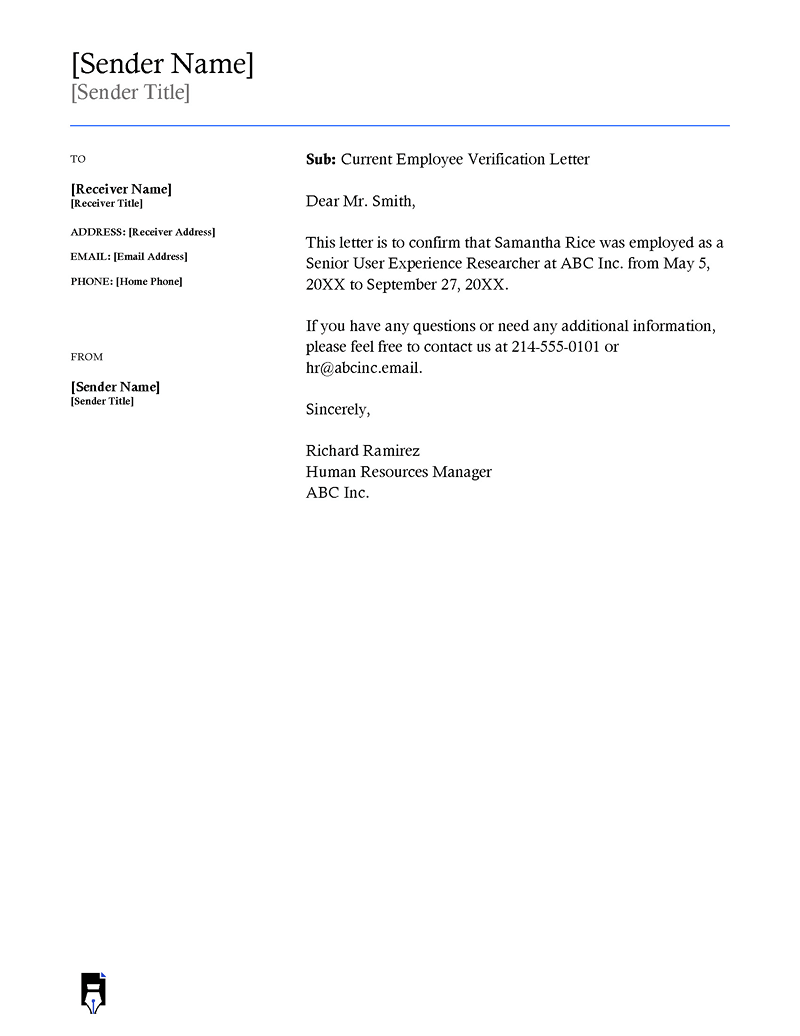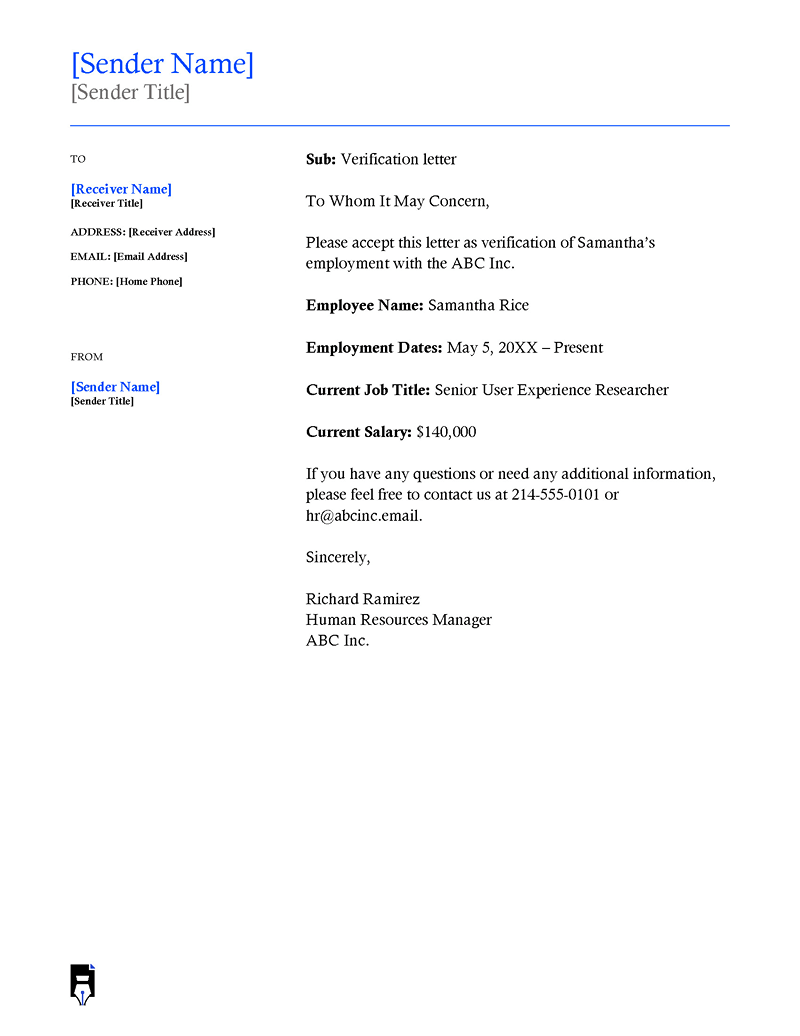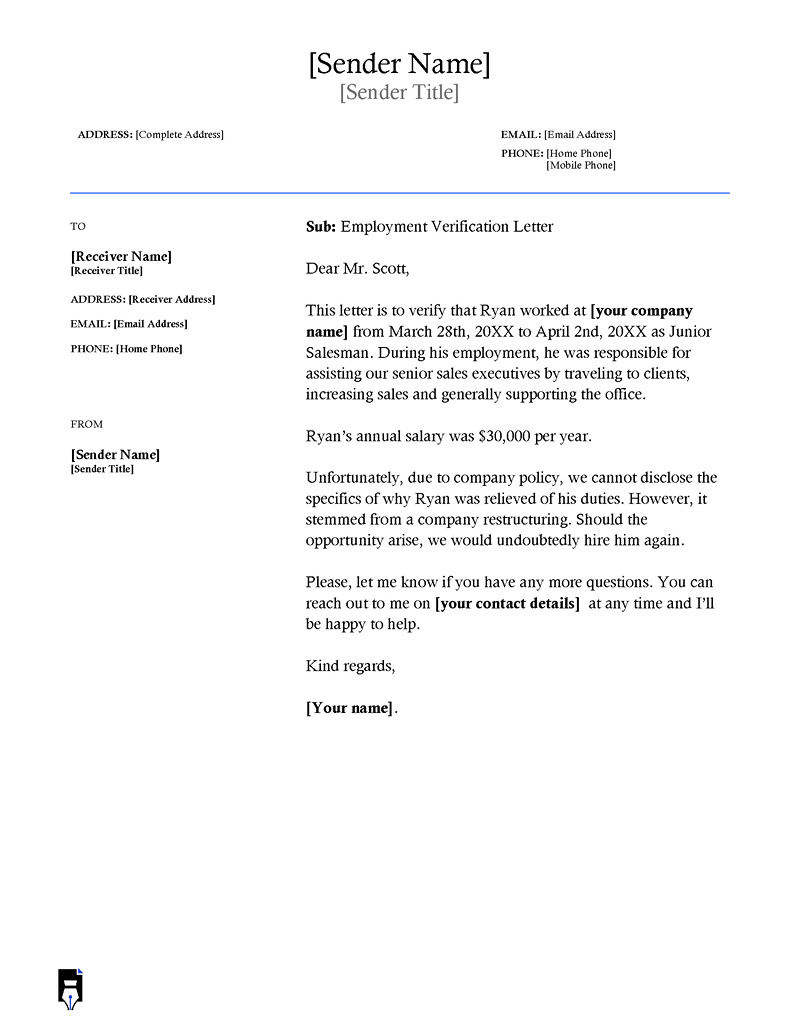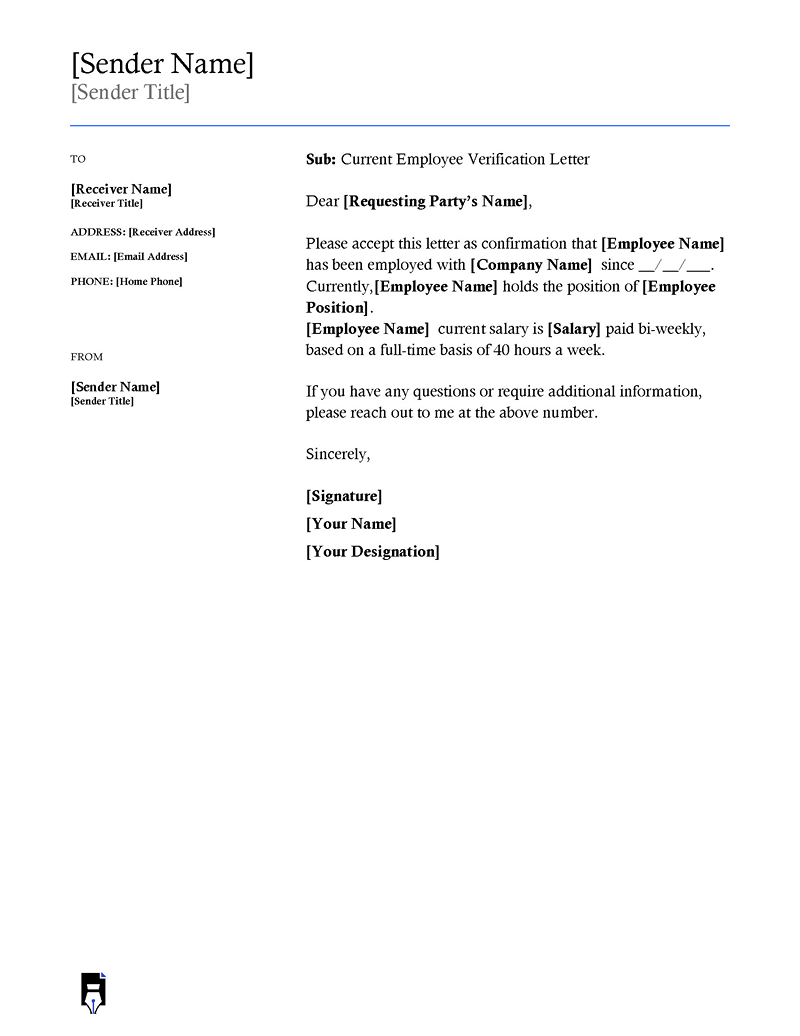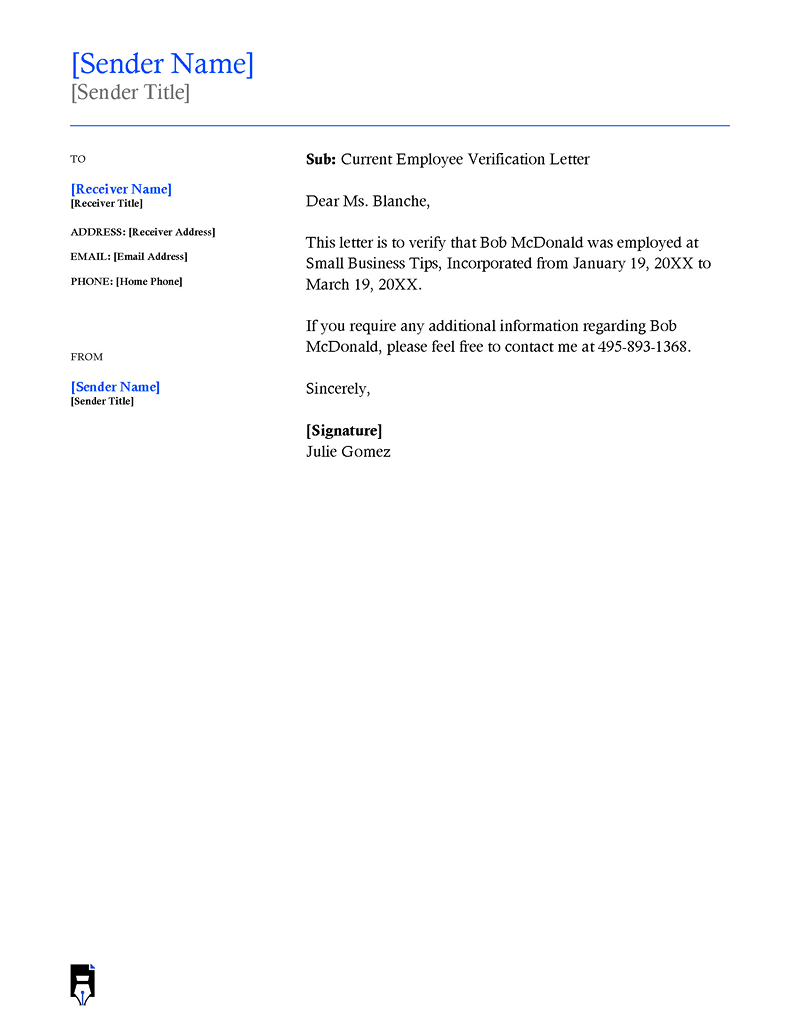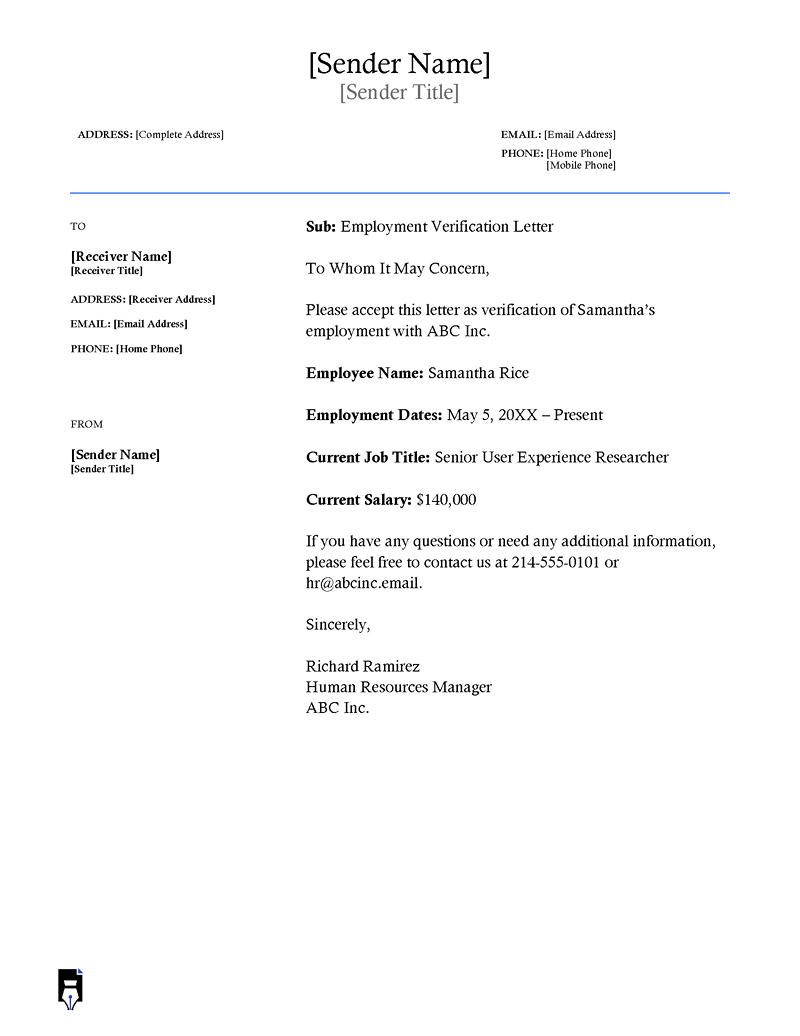If you have been in the job market for a while as an employer, you have probably been asked to give proof of employment to an employee before they can access particular services. Most employers, organizations, and even government institutions often require this proof to verify that the employee can fulfil their financial obligations. In these circumstances, you are required to issue employment verification letters. When employees ask for an income proof letter, they often need them for services like lease signing, visa application, and loan applications.
The parties involved in this process are the verifier, employee, and requester. The verifier is often the employee’s former employer or boss. The requester is the individual who needs proof of employment; it may be the employee’s potential landlord, current employer, immigration officer, or creditor, depending on the reason for requesting the letter. Since a verification letter is essential to your employee’s potential opportunities, you must know how to write one.
This article discusses what an employment verification letter is in detail. It describes instances when you might need to write one and what you should include when writing it. It also provides the best tips to use to write an effective letter.
Employment Verification Letter Template
As an employer, you may receive multiple requests for verification letters. However, writing a letter from scratch may be daunting if you have to do it several times. Instead, you should use a template. A pre-made template can help to save time as you will only need to edit the employment verification letter to fit the requester’s needs. In addition, it can help you avoid mistakes that may cost your employee’s a new job or a rejection of their rental lease.
Below are free-to-download and editable templates to prepare a comprehensive proof of employment letter:
What is an Employment Verification Letter?
A verification letter is a formal document used as proof that the employee has worked as your employee. Since the letter is a formal document, it should bear the company letterhead or official logo. Use company stationery bearing the company’s letterhead where you can.
The letter should be written by you or someone authorized as it is official communication. It includes details such as your name, the employee’s compensation, title, and responsibilities. It also shows how long an employee has worked for you. These letters help the requester to verify particular aspects of an employee’s employment history. If requested by a hiring manager, for example, it allows them to confirm details the employee/applicant has written in their resume.
Since the verification letter is used in many jurisdictions, it might bear different names depending on the reason for its request.
Some of these alternative names include:
- Proof of employment letter
- Experience letter
- Verification of employment
- Proof of income letter
- Letter of employment
- Work verification letter
- Income verification letter
Statistical insight: Some applicants exaggerate their experience in their resumes; hence the need for potential employers to verify the employee’s experience may not be accomplished. For example, a survey noted that 78% of applicants exaggerated their skill set, 60% exaggerated their level of expertise, 50% lied about the duration of employment, and 45% gave a false reason for leaving their former place of work.
When is Verification Letter Needed? 7 Common Situations
As an employer, you should write the letter yourself because you can access the employee’s files and verify the requested information. However, you may need to provide this information to a requester in various circumstances, including:
Applying for a green card
Green card holders are allowed to reside and work permanently in the United States. Because of this benefit, anyone sponsoring an applicant as their family or through marriage should give evidence of the employee’s financial stability. The verification letter forms part of the financial support form called Form I-864, or Affidavit of Support. Part of the financial support documents includes tax returns and an employment verification letter.
The letter is important for sponsors who have just taken employment at a place to show that they can provide for the employee once they successfully get the green card.
Getting a mortgage
If your employee wants a mortgage, their mortgage lender may require a verification letter to determine their creditworthiness. Most lenders are financial institutions; as such, they have guidelines and conditions to be fulfilled before they allow the employee to request a mortgage. In these letters, you will need to provide details on the compensation your employee used to get. The payment information can be used to set the mortgage repayment terms.
Applying for a tourist visa
For tourist visas, a verification letter acts as proof that the employee can sustain themselves financially and that they intend to stay in the foreign country as a tourist. In addition, the letter often shows that the employee has financial interests tied to their home country.
For example, in the United States, the U.S. Citizenship and Immigration Services (USCIS) requires visa applicants to provide proof of employment as part of the visa application. This proof of employment shows that the applicant has ties to their home country and intends to return once their tourist visa expires. In addition, the applicant often has to fill out Form DS-160- The Online Non-Immigrant Visa Application, where they will provide a verification letter.
Loan and credit application
Banks and other lending institutions require proof of employment to determine how much to lend the employee. The letter can also be used when calculating loan repayment terms. A letter written for this purpose should state the employee’s work hours and terms of payment; hourly or salaried.
Applying for a work visa
Work visas require the employee to prove that their purpose for application is to perform their employment duties in another country. To prove this, you should provide details on the employee’s position and proof that they will be working in a similar position in a foreign country. In the United States, work visas are commonly referred to as H-1B visas or L-1A/L-1B visas.
When applying for this visa, the USCIS requires the applicant to provide a verification letter to show the position they will be taking as an employee in the company they will be working. In addition, the H-1B visa requires the applicant to provide their resume and letter. The L-category visas require the applicant to have a minimum of one year of experience in the position they will be taking.
Lease application
The verification letter for rental applications is one of the ways landlords verify a potential tenant’s income. In addition, landlords can use the letter to determine whether the applicant afford to rent the apartment.
Selection and recruitment
Suppose your employee has applied and been shortlisted for a new job. In that case, the recruiter may request a verification letter to confirm the applicant’s job history details and check the employee’s background. In addition, recruiters often use these letters to confirm the duration of employment, levels of experience and expertise, and job titles the applicant holds.
Elements of an Employment Verification Letter
While the proof of employment letter serves different purposes, some details must be included in every letter. These essential details help the requester decide on your employee’s application.
They include:
Dates of employment
When writing the letter, state when the employee started working for you and when the employment was terminated. Employment dates allow the requester to determine the period of employment, especially where gaps in employment are a consideration for the requester. There is a variety of formats you can use when writing your dates.
For example:
-17/11/2019
-17th November 2019
-November 17, 2019
Job title
Job titles should generally be included in all verification letters. Where your employee is applying for a work visa, it might be used as proof of their expertise for the position they will take in their new place of work. For job applicants, recruiting managers may require the title to determine whether the applicant has sufficient experience in the role they seek to fill.
Employment classification
Employees are classified as full-time or part-time workers. The employee’s classification should be mentioned in your letter as it may influence the requester’s decision. For example, the requester may want to verify the employee’s work status to determine whether to employ them full-time or part-time.
Annual compensation
Requesters like potential employers may use the employee’s annual compensation to determine how much they should pay the employee if they offer them a position. Lenders may also use annual salaries to determine the schedule of loan repayments.
Employee’s roles and responsibilities
An employee’s roles and responsibilities are essential when looking for a new job. Verification letters for job applications and work visas must include information on the employee’s roles and responsibilities. It allows the requester to assess the employee’s suitability for the role they seek to fill.
Your signature
Your signature is as vital as the company’s letterhead. It verifies the document’s authenticity and proves that you were the document’s writer. In some cases, you can use the signature and company stamp.
Fact check: It is not uncommon for applicants to lie in their resumes. For example, 43% of applicants lie about relevant experience, 41% used a title senior to their actual employment title, i.e., the director instead of manager, 36% lied that they had experience, and 93% of people knew of someone who lied in their resume.
Employment Verification Letter Templates
[Sender’s name]
[Job title/position]
[Address]
[City, state, zip code]
[Date]
[Requester’s name]
[Title, company name]
[Address]
[City, state, zip code]
Dear [Requester],
I write this letter to verify [employee’s name] employment at [company name]. [employee’s name] has been employed at [company’s name] since [start date] to [end date]. The following are the details of their employment:
Employee status [part-time or full-time]
Salary [annual]
Roles and responsibilities
Please get in touch with me at [email and phone number] if you require more information regarding [employee’s name] employment.
Sincerely,
[Handwritten signature]
[Name]
Employment Verification Letter Sample
Peter Gandalf,
Human Resource Director, Pulp Inc.
789 Wood Ave,
Springfield, MN 4894
February 15, 2021
Smith Wesley,
Recruitment Manager, West Inc.
345 Avondale
Westwood, MN 4894.
Dear Mr. Smith,
This letter confirms that Mason Star was employed as a Technical Engineer at Pulp Inc. from January 2015 to December 2020. The following are the details of his employment:
Employee status: Full-time employee
Annual salary: $115,545
Roles
Repairing faulty and damaged computer hardware
Developing computer software programs
Running diagnostics and maintenance on existing software
I have enclosed his pay stubs and income tax returns for 2019 and 2020 for your consideration.
If you have any questions regarding Mason’s employment, do not hesitate to get in touch with me at 555-7890 or [email protected].
Sincerely,
Peter Gandalf,
Human Resource Director.
Tips and Tricks to Consider
A verification letter is a determinant factor in many jobs and visa applications. Since they are often reviewed quickly, it is crucial to keep them simple.
You can use the tips mentioned below to write an excellent verification letter:
Follow a business letter format
The standard business letter format comprises a header with contact information, an introductory paragraph, the body, and a conclusion. In addition, you should use a handwritten signature at the end of the letter. This standard format is recommended because it is applicable regardless of where you send the letter.
Keep it concise
Your employment verification letter often forms part of a more significant application or list of documents. Therefore, you should ensure it only contains the necessary details so it can be reviewed quickly.
Provide actual information
Since proof of employment letters are official documents, you should only provide factual information. Furthermore, the requester often only needs confirmation on relevant details. Therefore, you should avoid giving unnecessary information.
Include contact information
Your contact information will help the requester reach out to you if they need clarification. When giving your information, ensure you provide the most current contacts to make it easy for them to contact you.
Edit and proofread
As an employer, all official documents you prepare are expected to be precise. This precision includes producing documents that do not have spelling or grammatical errors. These mistakes can be avoided by proofreading and editing your letter before sending it.
Frequently Asked Questions
What can be used as proof of employment?
There are many ways of proving employment, including a verification letter. Other methods include pay stubs, bank records, and federal income tax statements. Some of these ways may vary when you are self-employed.
How do I write a letter of employment?
The business letter format is the best way to write an employment letter. This format begins with your address, the recipient’s address, salutation, introduction, body, conclusion, and a handwritten signature.
What should be the length of an employment verification letter?
The standard length of an employment verification letter is one A4-sized page. Longer letters are often assumed to have irrelevant details. Ensure you only include the relevant information to avoid writing a long letter.
